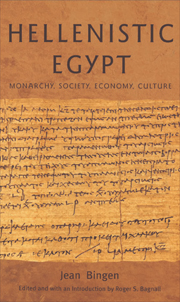Book contents
- Frontmatter
- Contents
- Original Sources of Chapters
- List of illustrations
- Glossary
- Maps
- Foreword
- Introduction: Jean Bingen and the currents of Ptolemaic history
- Part I The Monarchy
- 1 Ptolemy I and the quest for legitimacy
- 2 Ptolemy III and Philae: snapshot of a reign, a temple, and a cult
- 3 Cleopatra, the diadem and the image
- 4 Cleopatra VII Philopatris
- 5 The dynastic politics of Cleopatra VII
- Part II The Greeks
- Part III The Royal Economy
- Part IV Greeks and Egyptians
- Conclusion
- Bibliography
- General index
- Index of passages discussed
- HELLENISTIC CULTURE AND SOCIETY
3 - Cleopatra, the diadem and the image
from Part I - The Monarchy
- Frontmatter
- Contents
- Original Sources of Chapters
- List of illustrations
- Glossary
- Maps
- Foreword
- Introduction: Jean Bingen and the currents of Ptolemaic history
- Part I The Monarchy
- 1 Ptolemy I and the quest for legitimacy
- 2 Ptolemy III and Philae: snapshot of a reign, a temple, and a cult
- 3 Cleopatra, the diadem and the image
- 4 Cleopatra VII Philopatris
- 5 The dynastic politics of Cleopatra VII
- Part II The Greeks
- Part III The Royal Economy
- Part IV Greeks and Egyptians
- Conclusion
- Bibliography
- General index
- Index of passages discussed
- HELLENISTIC CULTURE AND SOCIETY
Summary
Verses familiar to every young student of classics sound the refrain, Nunc est bibendum, nunc pede libero pulsanda tellus, ‘It is now time to drink, time to strike the ground with a foot that nothing holds back any more.’ But from just what fear was Rome now delivered? Horace was writing close to the imperial milieu. The ode is an immediate echo, almost live, of the birth of the foundation myth of the empire that Octavian, the future Augustus, wanted to impose on Roman opinion and on future historians. The mortal threat to Rome which Octavian averted came from a monstrum fatale, a ‘monster capable of forcing fate’, a queen who was preparing the ruin of Rome and the destruction of an empire still in embryo. Fortunately, the myth goes, Octavian defeated her in Actium, which otherwise would have been the last stage before her sacrilegious conquest of Italy. However, it was only half a victory for Octavian: Cleopatra escaped from the encircling. To chain her up, Octavian – Horace wrote – swept down upon her like the hawk upon doves or the hunter upon a hare, two at least debatable images. Horace hides neither his admiration for the queen nor his misogyny: she did not behave like a weak woman; she faced up to defeat and refused to flee from Alexandria at the arrival of the enemy.
- Type
- Chapter
- Information
- Hellenistic EgyptMonarchy, Society, Economy, Culture, pp. 44 - 56Publisher: Edinburgh University PressPrint publication year: 2007



